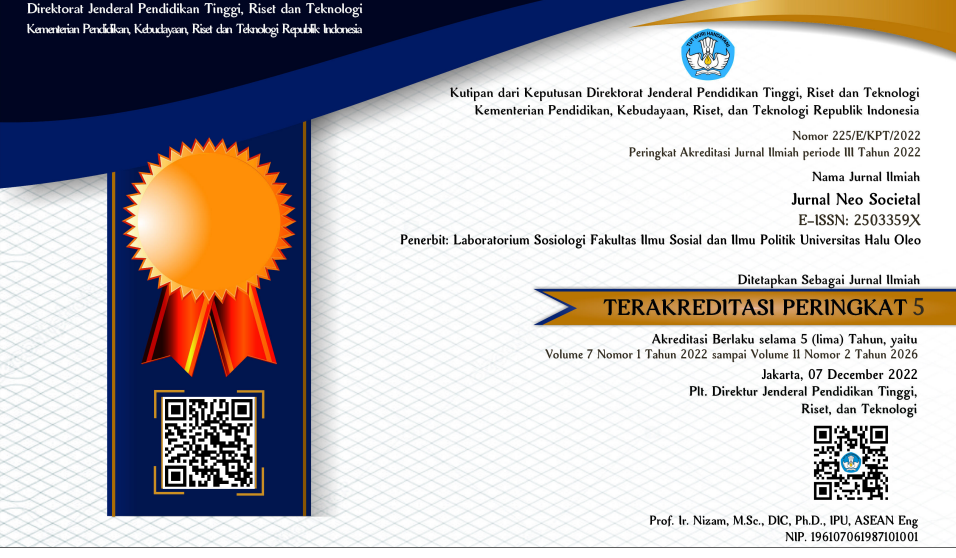DAMPAK MEDIA SOSIAL TERHADAP PEMBENTUKAN IDENTITAS SOSIAL ANAK DI ERA DIGITAL
SEBUAH TINJAUAN SOSIOLOGIS DI KOTA MAKASSAR
Keywords:
Social Media, Social Identity, Children, Makassar, Digital AgeAbstract
This study aims to analyze the impact of social media on the formation of children's social identity in the city of Makassar in the digital age. Using a qualitative approach and case study method, this research involves children aged 10-15 years who are actively using social media platforms such as Instagram, TikTok, and Facebook. The results show that social media plays a crucial role in the process of social identity formation through symbolic interaction, where children construct an ideal self-image to gain recognition and validation from their peers. However, alongside these benefits, children also face social pressures to always appear "perfect," which can affect their mental health, leading to anxiety and low self-esteem. The study further reveals that children in Makassar often experience conflicts between local cultural values, which emphasize family and cooperation, and the more individualistic global norms presented through social media. They must navigate between their real-world identities and the identities they are expected to display in the digital world. This research provides insights for parents, educators, and policymakers about the importance of healthy media literacy education and monitoring children’s social media use to help them build more positive and authentic social identities.
References
Badan Pusat Statistik (BPS) Makassar. (2022). Statistik Pengguna Internet di Makassar. BPS Makassar.
Berger, P., & Luckmann, T. (2016). The social construction of reality. In Social theory re-wired (pp. 110–122). Routledge.
Braun, V., & Clarke, V. (2006). Using thematic analysis in psychology. Qualitative Research in Psychology, 3(2), 77–101.
Creswell, J. W., & Creswell, J. D. (2017). Research design: Qualitative, quantitative, and mixed methods approaches. Sage publications.
Denzin, N. K., & Lincoln, Y. S. (2011). The Sage handbook of qualitative research. sage.
Erikson, E. H. (1968). Identity youth and crisis (Issue 7). WW Norton & company.
Goffman, E. (2002). The presentation of self in everyday life. 1959. Garden City, NY, 259.
Keles, B., McCrae, N., & Grealish, A. (2020). A systematic review: the influence of social media on depression, anxiety and psychological distress in adolescents. International Journal of Adolescence and Youth, 25(1), 79–93.
Kim, H., & Kim, J. (2018). Identity conflict of adolescents in the global digital age: A qualitative study on identity crisis in Korea. International Journal of Adolescence and Youth, 23(2), 175–190.
Manca, S., & Guarino, A. (2018). Exploring the role of social media in the identity construction of young people. Journal of Youth Studies, 21(7), 855–871.
Mead, G. H. (1934). Mind, self, and society: From the standpoint of a social behaviorist. In University of Chicago Press.
Mead, G. H. (2018). George Herbert Mead on social psychology. University of Chicago Press.
Potts, A. (2015). A theory for educational research: Socialisation theory and symbolic interaction. Education Research and Perspectives, 42, 633–654.
Putri, M., & Nasril, N. (2023). Pengaruh Media Sosial Terhadap Identitas Diri Remaja. AL MUNIR: Jurnal Komunikasi Dan Penyiaran Islam, 14(1), 75–85.
Stake, R. (1995). Case study research. Springer.
Twenge, J. M. (2017). iGen: Why today’s super-connected kids are growing up less rebellious, more tolerant, less happy and completely unprepared for adulthood and what that means for the rest of us. Simon and Schuster.
Yin, R. K. (2009). Case study research: Design and methods (Vol. 5). sage.
Downloads
Published
How to Cite
Issue
Section
License
Copyright (c) 2024 Andi Nurlela, Atma Ras, Musrayani Usman

This work is licensed under a Creative Commons Attribution 4.0 International License.













